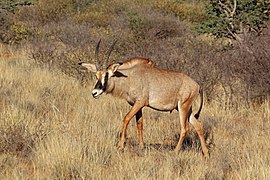
A bestiary is a compendium of beasts. Originating in the ancient world, bestiaries were made popular in the Middle Ages in illustrated volumes that described various animals and even rocks. The natural history and illustration of each beast was usually accompanied by a moral lesson. This reflected the belief that the world itself was the Word of God and that every living thing had its own special meaning. For example, the pelican, which was believed to tear open its breast to bring its young to life with its own blood, was a living representation of Jesus. Thus the bestiary is also a reference to the symbolic language of animals in Western Christian art and literature.

The unicorn is a legendary creature that has been described since antiquity as a beast with a single large, pointed, spiraling horn projecting from its forehead.

The European dragon is a legendary creature in folklore and mythology among the overlapping cultures of Europe.
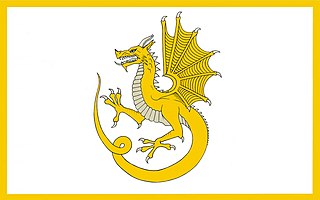
The wyvern is a type of mythical dragon with two legs, two wings, and often a pointed tail which is said to be a venomous stinger.
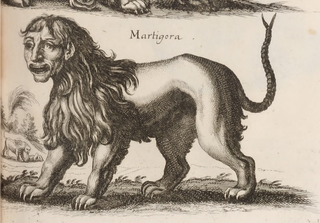
The manticore or mantichore is a Persian legendary creature similar to the Egyptian sphinx that proliferated in western European medieval art as well. It has the head of a human, the body of a lion and the tail of a scorpion or a tail of venomous spines similar to porcupine quills. There are some accounts that the spines can be launched like arrows. It eats its victims whole, using its three rows of teeth, and leaves no bones behind.

A cockatrice is a mythical beast, essentially a two-legged dragon, wyvern, or serpent-like creature with a rooster's head. Described by Laurence Breiner as "an ornament in the drama and poetry of the Elizabethans", it was featured prominently in English thought and myth for centuries.

In heraldry, a charge is any emblem or device occupying the field of an escutcheon (shield). That may be a geometric design or a symbolic representation of a person, animal, plant, object, building, or other device. In French blazon, the ordinaries are called pièces, and other charges are called meubles.

The Tudor rose is the traditional floral heraldic emblem of England and takes its name and origins from the House of Tudor, which united the House of Lancaster and the House of York. The Tudor rose consists of five white inner petals, representing the House of York, and five red outer petals to represent the House of Lancaster.
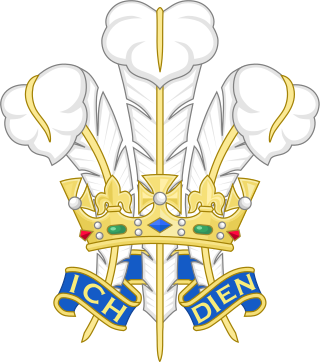
A heraldic badge, emblem, impresa, device, or personal device worn as a badge indicates allegiance to, or the property of, an individual, family or corporate body. Medieval forms are usually called a livery badge, and also a cognizance. They are para-heraldic, not necessarily using elements from the coat of arms of the person or family they represent, though many do, often taking the crest or supporters. Their use is more flexible than that of arms proper.
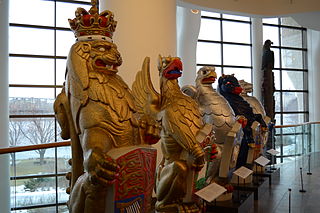
The Queen's Beasts are ten heraldic statues representing the genealogy of Queen Elizabeth II, depicted as the Royal supporters of England. They stood in front of the temporary western annexe to Westminster Abbey for the Queen's coronation in 1953. Each of the Queen's Beasts consists of a heraldic beast supporting a shield bearing a badge or arms of a family associated with the ancestry of Queen Elizabeth II. They were commissioned by the British Ministry of Works from the sculptor James Woodford, who was paid the sum of £2,750 for the work. They were uncoloured except for their shields at the coronation. They are now on display in the Canadian Museum of History in Gatineau, Quebec.

A Panther is a creature in ancient legend that resembles a big cat with a multicoloured hide.

The House of Beaufort is an English noble and quasi-royal family, which originated in the fourteenth century as the legitimated issue of John of Gaunt, 1st Duke of Lancaster and his long time mistress Katherine Swynford. Gaunt and Swynford had four children: John Beaufort, 1st Earl of Somerset (1373–1410); Cardinal Henry Beaufort, (1375–1447), Bishop of Winchester; Thomas Beaufort, Duke of Exeter (1377–1426) and Joan Beaufort, Countess of Westmorland (1379–1440). When Gaunt finally married Swynford as his third wife in 1396, the Beaufort children were legitimized by Pope Boniface IX and by royal proclamation of the reigning monarch King Richard II, who was John of Gaunt’s nephew.

The griffin, griffon, or gryphon is a legendary creature with the body, tail, and back legs of a lion, and the head and wings of an eagle with its talons on the front legs.

In heraldry, the term attitude describes the position in which a figure is emblazoned as a charge, a supporter, or as a crest. The attitude of a heraldic figure always precedes any reference to the tincture of the figure and its parts. Some attitudes apply only to predatory beasts, exemplified by the beast most usual to heraldry – the heraldic lion; other terms apply to docile animals, such as the doe, usually emblazoned as a "hind".
The calygreyhound is a mythical creature that appears on medieval heraldry. The de Vere family, who were the Earls of Oxford, used the calygreyhound in their coat of arms in the 15th and 16th centuries. The calygreyhound may be unique to the de Veres, and unlike most heraldic monsters, it made no attempt to seem realistic. A similar monster is the caretyne.

The royal standards of England were narrow, tapering swallow-tailed heraldic flags, of considerable length, used mainly for mustering troops in battle, in pageants and at funerals, by the monarchs of England. In high favour during the Tudor period, the Royal English Standard was a flag that was of a separate design and purpose to the Royal Banner. It featured St George's Cross at its head, followed by a number of heraldic devices, a supporter, badges or crests, with a motto—but it did not bear a coat of arms. The Royal Standard changed its composition frequently from reign to reign, but retained the motto Dieu et mon droit, meaning God and my right; which was divided into two bands: Dieu et mon and Droyt.

The Forest Bull, also known Ethiopian Bull and Ethiopian Forest Bull, is an animal from ancient and medieval bestiaries. According to Pliny the Elder, they were a breed of ferocious, tawny cattle living in Ethiopia, with mouths gaping open to the ears. Their horns, like a Yale's, could swivel in any direction. To fight, they raised them, after which the horns remained in this position. According to Aelian, they were called "flesh eaters" and were the most ferocious and savage of all animals. They were twice the size of regular bulls and could run at great speeds. He cites their hair as being red. No weapon could physically hurt the bulls, be it spears or arrows because even iron deflected from their skin. The forest bulls hunted herds of wild animals and horses. To protect their flocks, herdsmen who lived in the area dug deep ditches, in which the bulls would fall and consequently choke on their rage. The Troglodytae (cave-dwellers), a nearby tribe, supposedly "judged [this] to be the king of beasts, and rightly so, for it possesses the courage of a lion, the speed of a horse, the strength of a bull, and is stronger than iron."
The royal supporters of England are the heraldic supporter creatures appearing on each side of the royal arms of England. The royal supporters of the monarchs of England displayed a variety, or even a menagerie, of real and imaginary heraldic beasts, either side of their royal arms of sovereignty, including lion, leopard, panther and tiger, antelope and hart, greyhound, boar and bull, falcon, cock, eagle and swan, red and gold dragons, as well as the current unicorn.
Theow, also called thos, thea or thoye, is a hybrid heraldic beast, represented by a wolf with goat's hooves.



